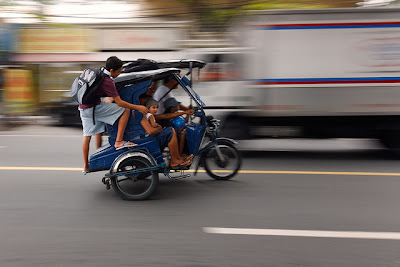Panning is a technique used in photography to suggest motion. It makes the main subject stand out from the rest of the scene emphasizing movement.
In panning the main subject will appear frozen but the background will be streaked in the opposite direction of the subject’s movement.
Tips, Tricks and Techniques to Master Panning
 |
| Photo By Sinu S Kumar |
- Although it is possible to take panning shots with a point and shoot it is a lot of hassle. So it is recommended that you use a DSLR to take panning shots.
- Set your camera to Shutter Priority Mode (TV).
- The shutter speed required to create the illusion of movement (amount of blur) actually depends on the speed at which the subject is moving. It is possible to successfully take panning shots of very fast moving objects with shutter speeds as high as 1/200 but for slower moving subjects you will have to use slower shutter speeds in the range of 1/60, 1/30 and even 1/15. A fast moving object such as a Motor cycle or a car on a race track could be easily shot at 1/200 while a cyclist cruising the streets could only be panned with speeds below 1/60.
- Keep your subject in the exact same position in your frame.
- Either use continuous focus (AI servo) mode or pre focus to avoid focus delays.
- Start tracking your subject even before it reaches your desired area to shoot and continue panning even after you have taken your shots. It helps to get into a fluid panning motion with a follow through.
- Once you start panning lock on to your subject by half pressing the shutter; pan along, keeping it half pressed and only triggering the shutter when it reaches the desired area, follow the subject a little more after you have taken your shots.
- Use the Continuous Shooting mode and take a series of shots in quick succession, that way the chances of getting a usable frame are quite high.
- In order to create great panning photographs, your camera should only move in the horizontal axis. Although it is quite possible to get great panning photographs hand-holding the camera; A monopod or a tripod with a swivel head would make your life a whole lot easier.
- If you are panning while hand-holding your camera, get into a comfortable stance; keep your feet still and only rotate your upper body to track your subject.
- Panning at the same speed at which your subject is travelling will ensure that the subject stays sharp.
Like any other technique panning also requires a little bit of practice before you could truly master the art. Start out with panning on faster moving subjects, as it allows the use of higher shutter speeds with which it is relatively easy to achieve acceptable results.
As you advance in your skills, you could try slower subjects. But remember it is a tricky thing to keep slow moving subjects in the same position of the frame for longer periods without inducing jerk. A great place to practice is somewhere along the highway where you will have endless supply of subjects to work with.
In the next article we will discuss about Photography - Photography Techniques -
ZoomingRelated Reading





Post a Comment